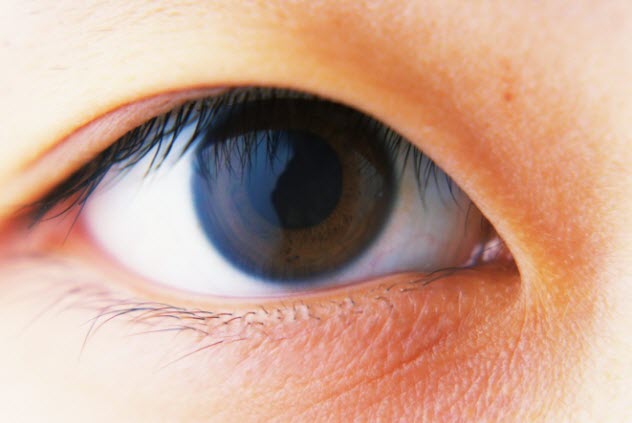10 Epicanthic Folds
An epicanthic fold is skin from the upper eyelid covering the inner corner of the eye, most commonly seen in people of East Asian descent. The classic explanation for the fold was that it developed in tropical regions as protection from UV rays or in Arctic regions as insulation from the cold. But this doesn’t explain how it emerged and was maintained among Asian populations in regions that were neither tropical nor Arctic. Some believe the epicanthic fold emerged as a way to protect the eyes of steppe-dwelling peoples from dusty winds or as protection in regions where the Sun reflects off light surfaces. It may be associated with minimal brow ridges in some populations because brow ridges also help to protect the eyes. As epicanthic folds didn’t seem to make any significant difference to the lives of those who have them, others believe it was simply a neutral adaptation that was passed on and perhaps proliferated due to sexual selection pressures. Epicanthic folds are also found among Native Americans, the Khoisan of southern Africa, Polynesians, and even some Europeans, especially the Irish, as seen with President John F. Kennedy. It is also a trait found in infants of all races, and its continued presence may be associated with some developmental disorders such as Down’s syndrome. For this reason, in the early 20th century, children affected by such disorders were called “Mongoloid.”
9 Red Hair
Red hair is a recessive genetic trait caused by a mutation of the melanocortin 1 receptor (MC1R), most commonly found among Germans and Celtic peoples in Scotland and Ireland. It is also known among Udmurts and Tajiks in Central Asia. The mutation must be inherited from both parents in order to manifest, meaning there are many more people carrying genes for red hair than there are red-haired people. There are also a number of variations on the MC1R mutation, resulting in various shades of red hair as well as admixtures with other shades, which cause colors like strawberry blonde and auburn. Pigmentation in human skin is caused by two forms of melanin: eumelanin, a brown/black polymer responsible for dark hair and skin, and pheomelanin, which has a pink or red hue and is present in the lips, nipples, and genitals. Having higher levels of pheomelanin than eumelanin leads to pale skin, red hair, and freckles. The evolutionary advantage of this adaptation was to allow people in northern latitudes and rainy countries to absorb more vitamin D. The downside is that redheads are more susceptible to sunburn, skin cancer, and thermal pain. They also require higher amounts of anesthetics in hospitals. The genes for red hair appeared in modern humans around 40,000 to 50,000 years ago. There was also an unrelated mutation in Neanderthals which produced a similar result of red hair and pale skin. It is believed to have arisen in our Neanderthal cousins as an adaptation for more efficiently synthesizing vitamin D, the same reason these genes developed in us.
8 White Skin
The pale skin associated with Europeans is something of a genetic rarity. The skin color gene SLC24A5 comes in two varieties: dark (D) and light (L). Everyone inherits one version of the gene from each of his parents. Those with the DD variety tend to be very dark-skinned, those with LL are usually very pale, and those with DL fall somewhere in between. This explains why children can be darker or lighter than their parents as well as why one of the Aylmer twins has dark skin and dark hair while the other has pale skin and red hair. Scientists once believed that ancient European populations developed pale skin after leaving Africa 40,000 years ago as an adaptation to help them absorb more vitamin D at northern latitudes where there’s less UV light than in the tropics. The theory goes that the first dark-skinned Europeans began getting sick from vitamin D deficiency, which can weaken the bones, and those with lighter skin had an evolutionary advantage in that environment. But things are not so simple in the world of genetics. Although humans first migrated into Europe about 30,000 to 40,000 years ago, more recent studies have suggested that Europeans were dark-skinned until around 8,000 years ago, possibly even later. Genetic tests on 8,000-year-old skeletons in Spain discovered that one of the individuals had the genetic markers for blue eyes but not for light skin and was more closely related genetically to modern northern Europeans than modern southern Europeans. The new theory is that Neolithic farmers developed light skin to get more vitamin D from the Sun but only after developing agriculture and adopting a cereal-rich diet deficient in the vitamin. Early European hunter-gatherers would likely have been tall, dark-skinned, and occasionally blue-eyed, in stark contrast to the short, pale-skinned farmers who would later take over the continent.
7 Blue Eyes
New research has indicated that we have a single ancestor to thank for blue eyes. Originally, everyone had brown eyes, with the variation between brown and green eyes explained by varying levels of melanin in the iris. OCA2 is a gene that controls the production of melanin in our skin, hair, and eyes. Around 6,000–10,000 years ago, there was a mutation in this gene. It didn’t turn off melanin production completely, but it did reduce the production of melanin in the iris, creating blue eyes. The exact amount of melanin in blue eyes is subject to only minor variation, which suggests blue eyes can be traced to a single evolutionary ancestor. While the exact genes responsible for brown eyes vary wildly, studies on blue-eyed individuals as far apart as Jordan, Denmark, and Turkey have shown consistently that a mutation in the OCA2 gene is responsible for the appearance of blue eyes. From a biological point of view, blue eyes are a neutral mutation. They don’t affect an individual’s survival and are simply a result of genetic shuffling. Originally, the emergence of blue eyes was believed to have been a side effect of the development of pale skin, but that wouldn’t explain the appearance of dark-skinned Europeans with blue eyes. It seems more likely that blue eyes spread so widely across Europe as a result of sexual selection. The theory is that blue-eyed individuals were considered attractive, found mates more easily, and spread their genes as a result. Of course, we can’t prove that, but some people believe that’s a logical explanation. Perhaps every blue-eyed person in the world owes something to a single Neolithic Casanova with baby blue eyes.
6 Dark Skin
It appears that ancient humans generally had dark skin, and light skin was an evolutionary adaptation to the environment in Europe (and East Asia). However, dark skin may also have originated as an evolutionary advantage to protect against skin cancer when the very early hominids began to lose their body hair. A study on albinism in Africa has shown that albinos in sub–Saharan Africa almost invariably die of skin cancer at an early age. Charles Darwin and other theorists had dismissed skin cancer as an evolutionary force because it usually strikes people after childbearing age in modern times. But this may not have been true two million years ago on the African savanna. When the earliest human ancestors began to hunt and gather on the open plains, they lost most of their body hair, most likely to keep cool in their strenuous lifestyle. Beneath their hair, they most likely had pale skin, much like modern chimpanzees. However, between 1.2 million and 1.8 million years ago, Homo sapiens developed dark skin to protect against harsh UV rays. According to researchers, humans may have developed dark skin to avoid painful sunburns, improve vision (low pigments are linked with vision problems), protect sweat glands from the Sun, and preserve the body’s folic acid supply, which is crucial for neural development and potentially damaged by UV rays. Dark skin may also protect against fungal infections in humid climates. Darwin and evolutionary biologist Jared Diamond believed that selection for dark skin was based on sexual selection pressures. But the research on albinos suggests the situation for the pale protohumans running around hunting animals may have been more dire, and the skin cancer explanation for the development of dark skin is once again being seriously considered.
5 Asian Flush
Drinking alcohol causes enzymes in the liver called “alcohol dehydrogenases” (ADHs) to convert alcohol into an organic compound called “acetaldehyde,” which is then converted to acetic acid by another enzyme. Fifty percent of Asians and 5 percent of Europeans have mutations in these enzymes that increase the rate of alcohol metabolism up to 100 times. This causes a rapid building of acetaldehyde, making the capillaries in the face dilate, which turns the face red. It may also cause nausea and headaches. After geneticist Kenneth Kidd of Yale University suggested that ADH1B47His, one of the mutations causing this effect, may have emerged as part of natural selection, a team of scientists from the Kunming Institute of Zoology studied 2,275 people representing 38 ethnic groups across China and determined that almost 99 percent of people in southeast China had the mutation. As this seemed to correspond with areas of early rice cultivation, the team believed there was a direct link. ALDH22, a related gene allele with a similar effect, is also present in the area. The mutation may have arisen among the Baiyue people of southeastern China as a response to the development of high-potency, rice-based alcoholic beverages. Those who carried the mutation causing “Asian Flush” were less likely to develop alcoholism and more likely to prosper in society. Basically, the flush was nature’s way of saying “Maybe you’ve had enough,” and those who didn’t flush were more likely to be too hungover to go to work or make babies. Others are less convinced, pointing to similar allergic reactions occurring in European and Indian populations. They also argue that the estimated dates for the emergence of the mutation and the development of rice agriculture don’t entirely match. However, these mutations do seem to have affected the development of some Asian societies because people with either of these genes have been shown to be statistically less likely to succumb to alcoholism.
4 Pygmy Stature
The Batwa and Baka people of the Central African rain forest are significantly shorter in stature than their neighbors and have become known as pygmies. Other groups expressing pygmy stature are known in the Andaman Islands, Malaysia, Thailand, Indonesia, the Philippines, Papua New Guinea, Brazil, and Bolivia. It is believed this short stature was an evolutionary advantage evolving independently several times over the course of human history. Scientists believe the short stature developed as a response to living in a rain forest environment. While rain forests are known for their extensive and complex ecosystems, there is often very little there that humans can eat. This led to theories that the pygmies were short simply because they were not receiving full nourishment. Small stature may have evolved as a way to conserve calories. Taller individuals also have a tougher time moving through dense vegetation, and the humidity of the rain forests makes it difficult for larger individuals to sweat and cool their bodies down. Recent studies have shown that pygmy stature is more likely a genetic trait that evolved as an adaptation from the environment rather than simply a lack of nourishment. Evidence of convergent evolution comes from a study of the genomes of the Batwa and Baka people, which were then compared with the genomes of their nearest neighbors. The pygmy traits in each group that were tied to stature and growth hormone apparently had different genetic roots, and both seemed to be adaptive genetic mutations beneficial to the pygmy populations. There are plans to extend these genetic studies to pygmy populations in Southeast Asia to analyze convergent evolution as a response to environmental pressure across continents.
3 Lactose Tolerance
Most infants can digest milk without any problems from the enzyme lactase, which breaks down a sugar found in milk called “lactose.” For most humans today and throughout history, the enzyme became inactive as an individual reached adulthood, so most people were lactose intolerant. Today, only 35 percent of the human population has lactose tolerance, including those of Northern and Central European descent along with some of African and Middle Eastern descent. The spread of lactose tolerance has been something of a mystery. About 8,000 years ago, humans living in the area that is now Turkey began developing more frequent mutations close to the gene that makes the lactase enzyme. This allowed those people to consume milk safely in adulthood. The adaptation spread very quickly throughout Europe, the Middle East, and India, stopping only at the Himalayas. Independent adaptations with the same effect also emerged in other parts of the world. While milk is nutritious—containing calcium, micronutrients, proteins, and carbohydrates—the pressing need for a milk-drinking adaptation isn’t entirely clear. Our ancestors had already determined that turning milk into cheese or yogurt would make it digestible by breaking down the lactose, although this also reduced its caloric content by 20 to 50 percent. There are various explanations for why drinking milk became such an advantage that it spread quickly and widely. Some say that milk may have provided nutrients absent in many early domesticated crops. MIT geneticist Pardis Sabeti believes that milk boosted women’s fat stores and increased fertility. Milk may have also served as an alternative and safer water source or been used to supplement the diet when crops failed. Anthropologist Henry Harpending argues that the caloric boost provided by milk consumption may have allowed populations to weather famines better and conquer others more easily, which led to the expansion of their civilizations. The rise of lactose tolerance is given as proof that the human race is still evolving. Today, lactose tolerance exists at varying levels within 90 percent of the human race, with low tolerance or intolerance most prevalent among populations of African, Asian, or Mediterranean descent.
2 Sickle-Cell Anemia
A genetically transmitted blood disease, sickle-cell anemia causes human red blood cells to adopt an unusual sickle or crescent shape. If an individual inherits one copy of the sickle cell gene from both parents, the disease will manifest in that person, causing health problems and reduced life expectancy. Normally, this should make a mutation rare among humans, but sickle-cell anemia is known worldwide, appearing in North America, Southern Italy, Northern Greece, Southern Turkey, the Middle East, Saudi Arabia, the Eastern Province of Central India, and most prominently in equatorial Africa. Examinations of the haplotypes of the mutations have led scientists to believe that the mutation has arisen independently four times: three times in West and Central Africa and once in India. Sickle-cell anemia is a common mutation in areas heavily affected by malaria. The sickle cell shape kills malaria parasites, causing them to adhere to the cell walls. The medical community has long been interested in learning exactly how sickle cells protect against the spread of malaria. Earlier studies have suggested there is something in the hemoglobin of sickle cells which gets in the way of the Plasmodium infection that causes malaria. However, recent studies by researchers at the Instituto Gulbenkian de Ciencia (IGC) in Portugal have challenged these assertions. Studies on mice have shown that sickle hemoglobin doesn’t interfere with the parasite’s infection of blood cells but rather makes the host tolerant of the parasite. Sickle cells produce an enzyme called heme oxygenase-1 (HO-1). In turn, this produces carbon monoxide, which has been shown to protect the host from succumbing to the parasite without interfering with the parasite’s life cycle. Research team head Miguel Soares explained the findings in a press release: “Due to its protective effect against malaria, the sickle mutation may have been naturally selected in sub-Saharan Africa, where malaria is endemic and one of the major causes of death. Similarly, other clinically silent mutations may have been selected throughout evolution, for their ability to provide survival advantage against Plasmodium infection.”
1 Ashkenazi IQ
It has long been noted that Ashkenazi Jews tend to perform better on standardized IQ tests, generally scoring 12–15 percent higher than the mean value of 100. In 2005, Henry Harpending, an evolutionary anthropologist at the University of Utah, and Gregory Cochran, a controversial independent scholar, published a paper in The Journal of Biosocial Science contending that the advantage of the Ashkenazim had a genetic basis. The paper contended that genetic lysosomal storage diseases like Tay-Sachs, Gaucher’s disease, Niemann-Pick disease, and Mucolipidosis type IV, found disproportionately in the Jewish population, might paradoxically cause increased overall intelligence. If two copies of the genes for those diseases are inherited, they’ll manifest as disorders that can weaken or kill. However, if only one copy of a gene for one of these diseases is present, it is said to promote neuron growth, accelerate interconnection of brain cells, and possibly stimulate neuron proliferation in the DNA repair genes. Needless to say, that thesis was controversial. Harpending and Cochran’s paper was referenced but lacked footnotes, and some say it also lacked scientific rigor. Some people may have been afraid of the findings because rumors of Jewish “cunning” have always played a role in the history of European anti-Semitism. But Cochran argues that history is largely to blame for what happened. The forced isolation of Jews in ghettos and specified industries in the Middle Ages brought unusually strict evolutionary pressures that caused the rise of an adaptation with mixed results. The process could be seen as a kind of unwilling and unconscious eugenics program. Many social scientists remain unconvinced. Some believe in a genetic answer that’s more prosaic: Jews were forced into intellectually rigorous careers in trade and finance, so those with low IQs tended to drift away from the religion and culture through conversion. Others say the history of persecution served as a kind of survival-of-the-fittest mechanism. When a pogrom or massacre struck, the wealthiest and most intellectually capable Ashkenazim were best positioned to flee for survival. Others prefer cultural explanations. The religious edict to study the Torah is said to have boosted male literacy rates of Ashkenazi Jews to the highest in the world. Cultural traditions of bilingualism, chess, music, and high expectations may have also played a role. For many people, such arguments are especially compelling because they avoid the smell of anti-Semitism and are potentially accessible behaviors to improve intelligence across all human populations. Lactose is the least of David Tormsen’s problems. Email him at [email protected]




















